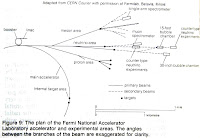 |
| Uranium nucleus, split by single neutron, transmutates to Krypton and Barium + release of 3 neutrons |
Chain reactions give measurable loss of mass via transmutation ...nuclear reactions (bombs, power plants etc)
Of interest are conventional exothermic reactions where net mass is lost but is un-measurably small
Of interest are conventional exothermic reactions where net mass is lost but is un-measurably small
(coal fired power stations, combustion of petrol, oxidation of sugars etc).
Could it be that net distances between electrons and nuclei equate to loss of mass in line with the energy level drop (liberated to environment)?
Given this, underpinned by sub-atomic before-after equity within the nuclei, one could say that particles closer together cause net lower mass by definition.
Given this, underpinned by sub-atomic before-after equity within the nuclei, one could say that particles closer together cause net lower mass by definition.
Extrapolating to the macro world we could say that when a person visits another, the loss of mass from energy expended in travel is function of masses being closer.
The universe is expanding so by this logic it’s becoming more massive, equating to energy increase.
Given premise of fixed amount of matter, does universal energy increase sufficiently to:
1. counteract increasing disorder from entropy increase
2. exceed energy loss from increasing entropy or
3. is insufficient to counteract, consistent with popularly accepted hypothesis that the universe is in fact winding down and has a use by date (variable within a range as function of how it's used) ?
Please show workings.
Heisenberg Uncertainty Principle states it’s possible to determine with great accuracy the position of an electron or alternatively it’s velocity …but never both.
ie one can never get a truly accurate snapshot of an event (sub-atomic or macro)
This is from limitations of any measuring apparatus.
A more generalized form of the principle states that whatever one attempts to observe is affected by the observer.
In the macro world one finds easy examples such as putting a meter on a battery …the small current required to deflect the meter loads the battery such that the measured terminal voltage will always be slightly lower than the unloaded voltage.

Another example may be taking a photograph.
The presence of photographer and/or camera will cause changes in the ambient lighting reflections of the room such that variations in light intensity/colour will occur relative to what would otherwise be.
In the world of atomic/subatomic particle accelerators/colliders eg CERN near Geneva, we have the situation of the theoretical physicist utilizing cutting edge mathematics to predict the existence of new particles.
The experimental physicist creates experiments to hunt/analyse any such phenomena that, given revelation within experimental error/measuring limitation, subsequently preserves and solidifies the hypothesis into the realm of accepted theory.
The electro-weak theory provided the first reliable estimates of the masses of W and Z particles (nearly 100 times the mass of a proton)
Discovery of these particles was crucial to acceptance of the unified electro-weak theory posited by Steven Weinberg, Abdus Salam and Sheldon Glashow in the 1970’s
Simon van der Meer (b Nov 24, 1925) Dutch physical engineer, with Carlo Rubbia, discovered these massive short-lived particles, being awarded the Physics Nobel Prize in 1984.
He devised a method for keeping two highly accelerated beams of protons and oppositely directed anti-protons from scattering out and hitting the walls of the 4 mile diameter CERN ring.
This promised a physical interaction sufficient in energy to form the predicted heavy particles.
The mechanism monitored scattering at a particular ring point and triggered a device on the opposite side to modify electric fields such that the particles stayed on course.
The interaction energy of the two beams: 630 GeV [Giga electron Volts]
The universe is expanding so by this logic it’s becoming more massive, equating to energy increase.
Given premise of fixed amount of matter, does universal energy increase sufficiently to:
1. counteract increasing disorder from entropy increase
2. exceed energy loss from increasing entropy or
3. is insufficient to counteract, consistent with popularly accepted hypothesis that the universe is in fact winding down and has a use by date (variable within a range as function of how it's used) ?
Please show workings.
 |
| Cern Accelerator (traverses the Franco-Swiss border) |
ie one can never get a truly accurate snapshot of an event (sub-atomic or macro)
This is from limitations of any measuring apparatus.
A more generalized form of the principle states that whatever one attempts to observe is affected by the observer.

The presence of photographer and/or camera will cause changes in the ambient lighting reflections of the room such that variations in light intensity/colour will occur relative to what would otherwise be.
In the world of atomic/subatomic particle accelerators/colliders eg CERN near Geneva, we have the situation of the theoretical physicist utilizing cutting edge mathematics to predict the existence of new particles.
 |
| Fermilab, Batavia Illinois |
The electro-weak theory provided the first reliable estimates of the masses of W and Z particles (nearly 100 times the mass of a proton)
Discovery of these particles was crucial to acceptance of the unified electro-weak theory posited by Steven Weinberg, Abdus Salam and Sheldon Glashow in the 1970’s
 |
| Cern Offices |
He devised a method for keeping two highly accelerated beams of protons and oppositely directed anti-protons from scattering out and hitting the walls of the 4 mile diameter CERN ring.
This promised a physical interaction sufficient in energy to form the predicted heavy particles.
The mechanism monitored scattering at a particular ring point and triggered a device on the opposite side to modify electric fields such that the particles stayed on course.
The interaction energy of the two beams: 630 GeV [Giga electron Volts]
.... [to be continued] ..




No comments:
Post a Comment